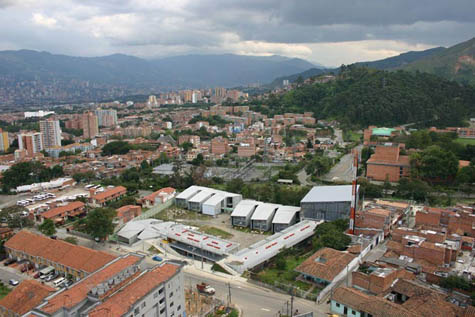 [Image: Filip Dujardin photographs a new building by Jan de Vylder Architects; spotted in Mark Magazine].
[Image: Filip Dujardin photographs a new building by Jan de Vylder Architects; spotted in Mark Magazine].I've long thought Mark to be one of the best architecture magazines out there – and, in full disclosure, I've written for them before – but it was nice to catch up with issues #20 and #21. In fact, on the way out of Australia last month I had dinner in a pizza restaurant in Surry Hills... where Mark Magazine, oddly enough, was available for customers to read. That particular issue included a great little essay by Tino Schaedler about comic book architecture, its translation into functional set designs by Hollywood concept artists (in this case, Alex McDowell), and the steps through which an imaginary building eventually appears on the silver screen. Schaedler's specific point of reference here was an Arctic structure from Zach Snyder's Watchmen.
Stand-outs from my afternoon reading experience of issues #20 and #21 include the earthbound office of Selgascano architects, with its lime green concrete walls and yellow pipework, and autumnal foliage hanging colorful and even Romantic above the building's transparent ceiling. All of it is semi-embedded into a Spanish hillside, and it looks like an amazing place to work. "The concept of the studio is very similar," the architects explain: "to work under the trees." (Warning: the firm's website is further proof that, if only architects could avoid being smooth-talked by Flash designers, then their work might be more widely known...).
The auditorium at Brest, by Bigoni-Mortemard Architects also caught my eye, with its call for public gardens, office space, and, of course, an auditorium. The bulk and looming mass of the concrete is something that, done right and twinned with the public gardens, could be extraordinary.
 [Image: Photos by Filip Dujardin of a new building by Jan de Vylder Architects].
[Image: Photos by Filip Dujardin of a new building by Jan de Vylder Architects].Paris-based Luxigon's rendering capabilities are made abundantly clear, as well, in the magazine's opening "Notice Board" spreads, which are full of the architectural eye-candy we all now know from blogs. Cinematic and exquisitely colored, Luxigon's work certainly puts them at the very top of their field: they produce knock-out images of unbuilt architecture in as accurate and seductive a way possible. I would love to see them do some environments for a graphic novel.
Sticking with this apparent French bias, meanwhile, Chartier-Carbasson Architects make an appearance with their exceedingly clever structural intervention on the side of a Paris public housing unit. By adding a large steel exoskeleton to an existing building, inside of which are brand new steps and doorways, the architects transformed a dead wall in the city, overlooking an unused site, into an unexpected facade. The resulting steel mesh is gorgeous – but I do have to express some reservations that, in a few years, in might appear quite claustrophobic and cage-like to the building's residents. Only time will tell, of course – but the basic idea here, that you can attach external parasites to the sides of existing buildings, and that these new addenda will bring with them structurally surprising new ways of gaining entrance to a building's interior, is an exciting one.
What other buildings throughout Paris – or New York, or Beijing, or elsewhere – could benefit from this literally lateral form of architectural augmentation? Such structures would almost be more like mine heads, opening up the world of architectural space, and not urban buildings at all.
Moving on, Mark also takes a look at the Forest Lookout Tower by SeARCH; and the bewilderingly awesome Orquideorama makes an appearance, as well.


 [Images: The Colegio Las Mercedes by Juan Manuel Pelaez].
[Images: The Colegio Las Mercedes by Juan Manuel Pelaez].Amidst the many other projects worth mentioning briefly here are the new ballet school and dance theaters by Jan de Vylder Architects, pictured above in photographs by Filip Dujardin; a sobering profile of architects Made in; and the Colegio Las Mercedes by Colombian architect Juan Manuel Pelaez.
I do have one definite complaint, however: Mark is an unbelievably heavy magazine. This sounds trivial – not to mention subjective – but this makes the issues quite difficult to travel with and a bit less than convenient to flip through out at a coffeeshop or park bench. So if something could be done about page weight and paper stock (and thus, perhaps, issue price), Mark would instantly be all but peerless.
No comments:
Post a Comment